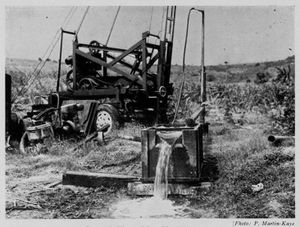Leeward Islands — Colonial Geological Surveys 1947–1956
| From Dixey, F. 1957. Colonial Geological Surveys 1947–1956: a review of progress during the past ten years. Colonial geology and mineral resources. Bulletin supplement No. 2. London: HMSO. |

Leeward Islands
Geological surveys in the Leeward Islands, British West Indies, were commenced in September, 1951, and were completed in March, 1956. They were undertaken by Mr. P. H. A. Martin-Kaye, who was seconded from British Guiana, and were financed entirely from Colonial Development and Welfare funds. The now de-federated Colony comprised several northern Lesser Antillean islands and included the British Virgin Islands of the Greater Antilles. In the latter, the geology is of an upturned and metamorphosed Upper Cretaceous volcanic and sedimentary series with later dioritic and other intrusions. St. Kitts, Nevis and Montserrat are islands of later Tertiary and Quaternary vulcanism, whilst Antigua and Anguilla are of middle Tertiary volcanics and overlying limestones. Barbuda and Anegada display only Pleistocene limestones. An account of the geology has been prepared and will be printed shortly.
Investigations into the prospects of improving water supplies from underground sources formed one of the main purposes of the survey, and these were carried out in detail in Antigua and the Virgin Islands and elsewhere locally as required. Results in Antigua have been most satisfactory and supplies are already considerably improved. Drilling continues here, but is still awaited in other islands. A report on the water supplies of the Virgin Islands was published in 1955 (Water Supplies of the British Virgin Islands, by P. H. A. Martin-Kaye, 69 pp.; Georgetown, British Guiana, 1955), and one for Antigua is in the press. Conclusions as to prospects in the other islands are to be incorporated in the general geological report.
Various mineral prospects have been investigated, but the only occurrence holding immediate promise is the copper/molybdenum mineralisation of the old copper-mining area of Virgin Gorda in the British Virgin Islands. Further subsurface prospecting seems warranted, and certain mining concerns are now interested in the locality. Occurrences of copper ores, haematite, graphite and siderite have been examined, and, although some are of interest, none is of economic significance. In the past, deposits of calcium phosphate have been worked on Sombrero, Anguilla and Barbuda, but examination shows that reserves are largely exhausted. It was not possible to demonstrate the reserves of aluminous phosphates remaining on Redonda; there is, however, little hope of renewed activity in this place, which is difficult of access. Islands of the Lesser Antilles also show slight indications of copper. Sulphur occurs in association with active fumaroles, but only in very small amount. Alunite occurs in some quantity in Nevis, and samples are still under examination. Salt is produced by solar evaporation of sea water in several islands ; the industry was described in detail in a report published in 1954 (Salt in the Leeward Islands, by P. H. A. Martin-Kaye, 58 pp.; Antigua, Government Printer, 1954).
A successful British Caribbean Geological Conference was held in Antigua in 1955 under the auspices of the British Guiana Geological Survey and various British Caribbean territories.
Mineral occurences
Alunite
Copper and copper ores
Graphite
Iron and iron ores
Molybdenite
Phosphates
Salt
Sulphur
Water supply